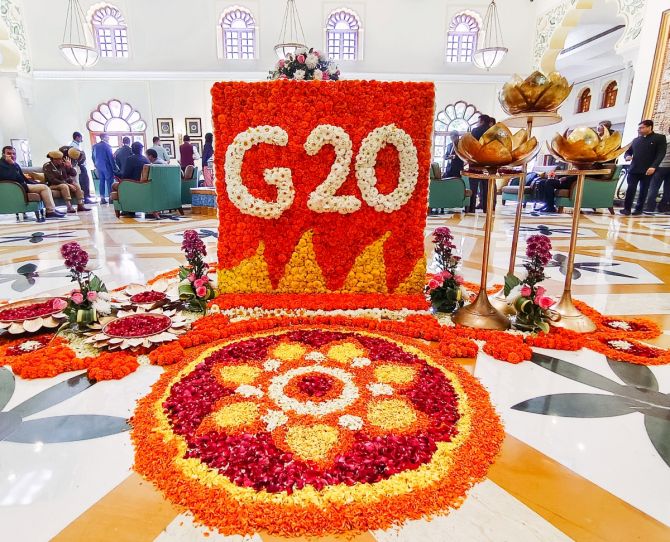'The Indian economy and the Indian financial sector today remain resilient and much better placed.'

Amid much debate over whether the current firm growth in bank credit is sustainable, Reserve Bank of India Governor Shaktikanta Das believes that loan growth is far from exuberant and instead, reflects the underlying fundamentals of the Indian economy.
The RBI is carefully monitoring the gap between deposit growth and credit growth, and a key factor to be considered is that the boom in credit over the last few months comes on the back of a sharp decline in loan growth during the COVID-19 crisis, Das said at the Business Standard BFSI Insight Summit in December, in a fireside chat with Tamal Bandyopadhyay, Consulting Editor, Business Standard.
Even as the world recovers from multiple crises such as COVID-19 and the Ukraine-Russia War, India's economy continues to show resilience while the central bank has its sights trained on ensuring that inflation remains under control, Das said.
The cryptocurrency war is over. Do you think you are a winner?
No, there is no war. We firmly believed then, and even now, that cryptocurrencies have absolutely no underlying.
Cryptocurrencies have certain huge inherent risks for our macroeconomic and financial stability.
We have been pointing this out and to developments over the last one year, including the latest episode that was built around FTX.
Time has proved that cryptocurrencies are worth what they are today.
Unlike any other asset or product, our main concern about crypto is that it doesn't have any underlying whatsoever.
There is talk that it should be regulated. How is it to be regulated? Somebody needs to explain.
I would like to mention three points. One, private cryptocurrencies do not believe in central bank currency; they do not believe in the regulated financial world.
They want to bypass and beat the system.
Two, they have absolutely no underlying.
I have yet to hear any credible argument about what public purpose it serves.
Three, it is a 100 per cent speculative activity.
Countries have been taking different views, but our view is that it should be prohibited.
If you try to regulate it and allow it to grow, mark my words -- the next financial crisis will come from private cryptocurrencies.
You launched the central bank digital currency (CBDC) pilot projects. Can you explain the use of CBDC?
I have earlier explained the difference between UPI (Unified Payments Interface) and CBDC.
The first difference is that UPI is a payment system, while CBDC is the currency itself.
Second, UPI involves intermediation by banks.
You pay somebody through your mobile, the message goes to the bank, your account gets debited, the bank transfers the money to the recipient's bank account, and the recipient's bank sends a message that so much money has been received.
So, there is intermediation by the bank.
CBDC is like currency notes. You go to the bank, draw it, keep it in your purse and spend it.
What is more, with CBDC there is an automatic sweep-in and sweep-out facility.
You can draw CBDC for all 24 hours, and if you are carrying excess CBDC, you can put it back into your bank account.
The third is that there isn't any cost of printing notes.
Manufacturing paper, getting the ink, and having a printing press, all these things will become outdated over a period of time.
Logistics-wise, CBDC will be much simpler, and much faster.
The next point is for international transactions.
When two countries have their own CBDCs, it can be an instant money transfer from one country to another.
The whole world is becoming more digital.
Many central banks are still in the experimental stage.
They are still analysing it. Some central banks have started pilot projects.
You will see that in the days to come, more and more central banks will embrace digital currencies.
India has been at the forefront of the digital revolution.
It is not a question of fear of missing out, or of offering competition to a private cryptocurrency.
Rather, it is how the world is going to evolve and the digital world is going to take shape in the days and years to come, and we have to be ready for that. It's a currency of the future.

How decoupled is India from the rest of the world? Whether we want it or not, our eyes are on the US Fed.
Being the largest economy in the world, naturally what the US Fed does matters to everyone, and a large part of global trade is also dollar-denominated.
Our monetary policy and other decisions are largely guided by our domestic inflation-growth dynamics and several other international factors.
The actions of the US Fed are studied, but that's only one of the factors.
Our monetary policies are governed and driven primarily by our domestic growth-inflation dynamics.
Actions of the US Fed do impact our domestic situation because, if there is tightening, let's say the dollar becomes stronger, naturally the price of our imported goods will go up.
Yes, the US is a major player. But let me reiterate that we are primarily governed by domestic factors.
Do we need to take a look at the composition of inflation, or does the RBI need to take a look at its assessment of inflation?
We constantly keep fine-tuning our models of inflation forecasting.
Any forecast, whether it is of inflation or growth, by any central bank, not just the Reserve Bank, is always conditional to so many factors.
Now, if the underlying conditions change or do not happen the way you had assumed, then naturally, the numbers will be different.
Sudden developments do take place. We keep fine-tuning our model.
What is important to see in the context of inflation forecasting is not whether you are getting the number right, but whether you are getting the direction of inflation right.
Are we able to read correctly that inflation is going to go up very fast, or go very steadily? So, it is the direction and speed underlying the inflation momentum, which is important -- not just getting that number right, because monetary policy is based not only on the direction of inflation, but the broad speed of inflation and the rise or decline of inflation.
In your latest assessment of growth, you pared it a bit. The World Bank assessment is higher. Why this sudden conservatism?
The World Bank, in its latest projection, has projected a growth of 6.9 per cent for the current year. We have given 6.8 per cent.
Primarily, it is because of global headwinds. Europe and other large countries are facing a serious growth slowdown.
The fear of recession, or the fact of slowing growth, is quite visible in large parts of the world.
This will affect external demand, and external demand does contribute a lot to our growth calculation through our export performance.
So, it is primarily international factors, the slowdown in growth all around, and the tightening of financial conditions the world over.
These external factors will have an impact on domestic growth, but the underlying economic activity in India continues to be strong.
Most fast-moving indicators -- RBI monitors about 70 fast-moving indicators -- were in the green box during the last month.
That means they are all picking up and still growing, but external factors are important, and they will cause some dent in our economy.
So, we have considered those aspects and, therefore, we have adopted 6.8 per cent.

Is the kind of credit growth that we are seeing year-on-year sustainable?
There are two aspects. First, credit growth of 17.5 per cent -- the number as of December 2 -- reflects the underlying fundamentals of our economy.
Credit growth in the previous two years was very modest.
In the first year of Covid, credit growth was just about 6 per cent; in the second year, it was slightly better.
So, the current 17.5 per cent is on a low base of the previous two years.
Second, current credit growth is reflective of the underlying fundamentals of the economy, and it is also a reflection of the pent-up demand for credit over the last two years.
Considering all these factors, credit growth currently is far from what exuberant.
It is definitely very steady. We are monitoring it very carefully.
On this point, let me also mention, because this question comes up again and again in any public discourse, that deposits are not growing and credit is growing.
Are we heading for an unsustainable situation? I agree that deposits must grow to sustain credit growth in the medium or long term, but also certain facts will have to be kept in mind.
Credit growth looks very high, because of the low base of the previous year.
Deposit growth also looks pretty low, because of the base effect of the previous years.
Deposits were growing by about 10 or 11 per cent during the Covid period, so deposit growth -- the latest data of 9.9 per cent -- is on a slightly higher base.
Looking at the absolute amount over a period of the last one year, credit growth in absolute numbers is Rs 19 trillion and deposit growth is Rs 17.5 trillion.
So, it is not as if there is a big gap between deposit growth and credit growth. The base effect is making it look much more divergent.
Is the banking system unfair to the saving community? You have an external benchmark for loan rates. What needs to be done if you want to attract savers?
Most banks have already started raising deposit rates.
Going forward, they will take a commercial call, as they do need deposits.
Banks also have a considerable amount of surplus SLR holdings, which they have the option to dip into any time they wish to.
The weighted average lending rate on fresh loans has gone up by about 117 basis points.
For fresh deposits, both retail and bulk deposits, deposit rates have gone up by 150 basis points.
Deposit rates are picking up. It's a function of the market.
Both lending rates and deposit rates are a function of the market and the Reserve Bank's policy rate.
Deposit rates are picking up and they may even go up a little more.

Everybody would like to know about India's presidency at G20. What opportunities do you see?
It is a great opportunity for India. India has now a much bigger role on the world stage. India will be chairing all the G20 meetings.
The biggest task for the world community, not just for India and the G20, is to restore the trust and efficacy of multilateralism.
After all, G20 represents 85 per cent of the world's GDP and about 75 per cent of world trade.
As a group it does matter a lot to the rest of the world.
Over the last few years, multilateralism appears to be losing its efficacy, whether in the context of fighting Covid or dealing with various other global problems.
The whole underlying theme of India is Vasudhaiva Kutumbakam, which means 'One Earth, one family, one future'.
So, it is one future which is important. The G20 as a group needs to address collectively the need to restore the efficacy and trust built around multilateralism. India today is uniquely placed to play that role.
Any message for this audience of bankers, NBFCs, insurers, and mutual funds? The microcosm of the entire Indian financial system is present here.
In the last three years, the world has seen in succession multiple shocks of extreme severity, three black swan events one after the other.
The Indian economy and the Indian financial sector today remain resilient and much better placed.
For that the credit goes not just to the regulators, but to all the participants and players in the financial sector. Together, all of us have done it.
But, there could be new challenges and new battles.
I am confident that the financial sector players and regulators, not just the RBI but other regulators too, will work together to maintain and strengthen the inherent resilience and capacity of the Indian economy.











